Raw Food Ingredients
How to Make Ceremonial Cacao in 10 Steps
Uncover the transformative power of ceremonial cacao in 10 steps, inviting you to embark on a journey of intention and heart-opening experiences.
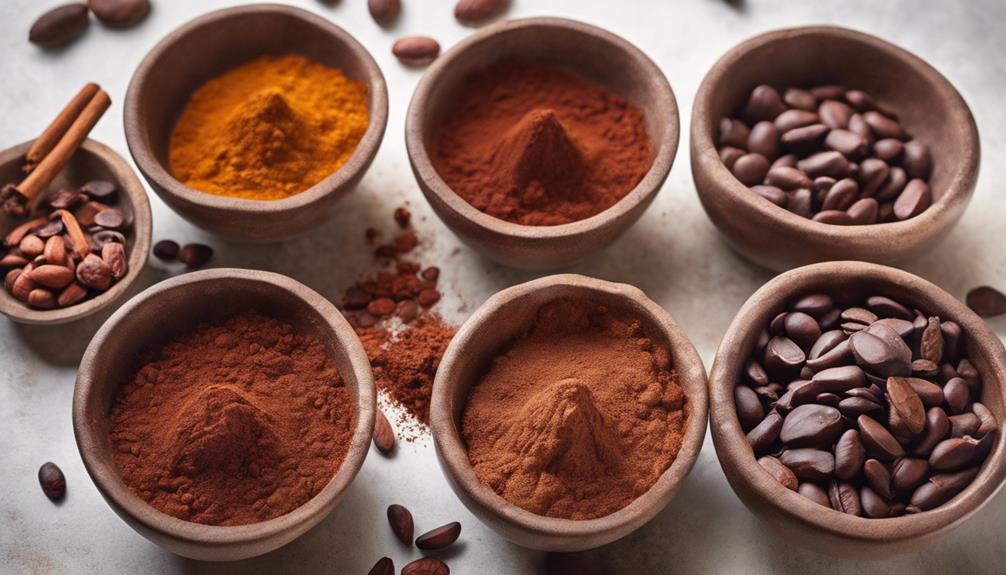
To create ceremonial cacao in a simple way, you need chopped or grated cacao, liquid, sweeteners, a ceremonial cup, and quality cacao. Heat the water to 170 degrees Fahrenheit for a perfect blend. Carefully select about 25g of cacao per person, then mix it with the liquid for a creamy beverage. Include sweetener to boost the taste. Before sipping, remember to set a meaningful intention for a more fulfilling experience. Establish your intention for the ceremony by setting clear goals. If you want to make the most out of this experience, follow these steps closely.
Infuse each sip with heartfelt intentions, savoring the rich flavors mindfully. Embrace the heart-opening benefits of ceremonial cacao, stimulating creativity and focus around the heart. The journey is just beginning, hinting at deeper connections and experiences awaiting those who engage in this ceremonial cacao practice.
Key Takeaways
- Gather cacao, liquid, sweeteners, ceremonial cup, and quality cacao.
- Heat water to 170°F, ensuring smooth consistency and full cacao dissolution.
- Choose a 25g cacao dosage per person for ideal flavor.
- Blend cacao discs with liquid to create a creamy drink.
- Set intentions, sip mindfully, and savor the rich flavors for a transformative experience.
Gather Necessary Ingredients
To make ceremonial cacao, gather the necessary ingredients such as chopped or grated cacao, spring water or preferred milk, natural sweeteners like coconut blossom sugar or raw honey, and a ceremonial cup.
When preparing ceremonial cacao, the quality of the cacao is of utmost importance. Make sure that you have 20-50g of chopped or grated cacao on hand. The cacao should ideally be sourced from reputable suppliers for an authentic experience.
Additionally, prepare 100-200ml of spring water or your preferred milk to mix with the cacao. This liquid will help create the rich, velvety texture characteristic of ceremonial cacao.
To enhance the flavor, consider adding natural sweeteners like coconut blossom sugar or raw honey. These sweet additions will complement the bitterness of the cacao, creating a harmonious blend of flavors.
Heat Water to Desired Temperature
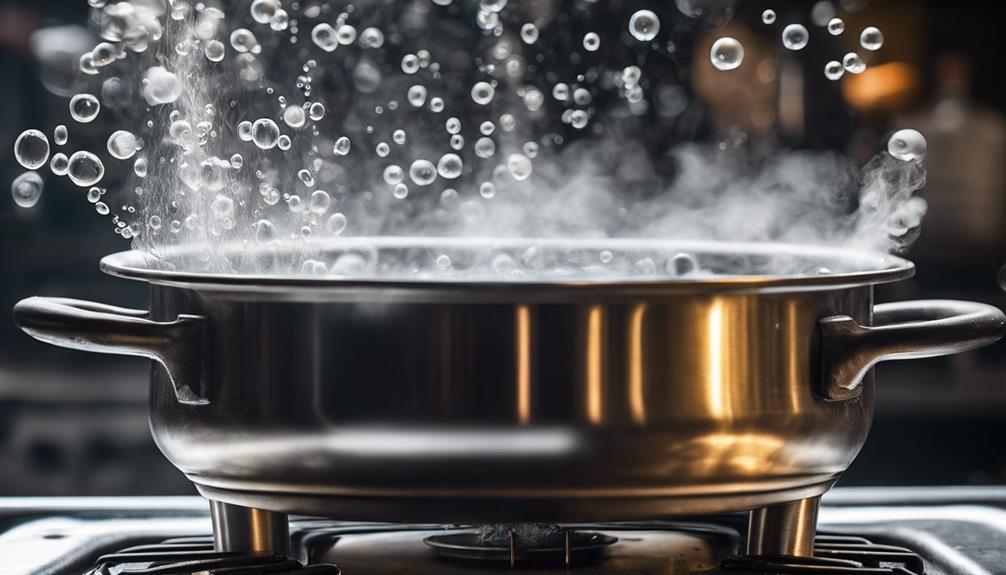
To make ceremonial cacao, heating water to the right temperature is essential for a perfect brew. This guarantees that the cacao melts properly, influencing the flavor and consistency of the final drink.
Using a thermometer can help you achieve the ideal 170 degrees Fahrenheit for a smooth and delicious ceremonial cacao experience.
Water Temperature Importance
Heating the water to 170 degrees Fahrenheit is essential for achieving the desired consistency in ceremonial cacao preparation. Proper water temperature is critical for extracting the flavors and benefits of the cacao. Here's why the water temperature matters:
- Smooth Consistency: Ideal water temperature helps in properly melting the cacao for a smooth texture.
- Full Dissolution: Heating water to the desired temperature guarantees the cacao is fully dissolved.
- Enhanced Taste and Texture: Water temperature impacts the overall taste and texture of the ceremonial cacao drink.
Maintaining the correct water temperature is a key step in creating a delicious and satisfying ceremonial cacao experience.
Achieving Perfect Heat
Maintaining the correct water temperature is key to achieving the perfect heat for ceremonial cacao, ensuring ideal flavor extraction and consistency.
To reach the desired 170 degrees Fahrenheit, start by heating water in a pot over medium heat. Once it begins to steam and tiny bubbles appear at the bottom of the pot, use a thermometer to monitor the temperature closely.
Avoid overheating, as boiling water can alter the cacao's taste. Once the water reaches the ideal temperature, remove it from the heat source promptly.
This precise water temperature is essential for revealing the full flavors and benefits of ceremonial cacao, providing a consistent and delightful experience with each sip.
Select Cacao Dosage Mindfully
When preparing ceremonial cacao, it's important to choose the dosage mindfully. Consider the effects of the cacao, ranging from heart-warming to profound experiences.
Your personalized dose selection will influence the intensity and overall experience of the ceremony.
Cacao Dosage Importance
Selecting the appropriate dosage of ceremonial cacao is fundamental for a meaningful and transformative cacao ceremony experience. When it comes to cacao dosage, remember these key points:
- The recommended ceremonial dose of cacao is typically around 25g per person, though some suggest using 42g for a more potent experience.
- There isn't a one-size-fits-all ceremonial dose; the effects vary based on personal preferences and intentions.
- Mindfully choosing the right amount of ceremonial cacao is vital for experiencing the heart-warming and profound effects of a cacao ceremony.
Properly weighing and measuring the cacao guarantees a balanced and impactful ceremonial drink, enhancing the spiritual and transformative aspects of the ceremony.
Mindful Consumption Considerations
Mindfully considering the appropriate dosage of ceremonial cacao is essential for a transformative and enriching cacao ceremony experience. When preparing your ceremonial cacao drink, it's important to start with the right amount to fully embrace the heart-warming effects.
For a standard dose, consider using around 25g of ceremonial cacao per person. If you're seeking a more profound experience, some practitioners recommend a dosage of 42g. These carefully selected amounts can enhance the overall impact of your ceremonial cacao journey.
Personalized Dose Selection
To fully engage in a meaningful ceremonial cacao experience, it's essential to contemplate the personalized dose selection thoughtfully. When selecting your cacao dosage for the ceremony:
- Start with a conservative amount and gradually increase if needed for a deeper experience.
- Consider your sensitivity to stimulants and adjust the dose accordingly.
- Listen to your body's responses during the ceremony to gauge the effects accurately.
Finding the right balance of ceremonial cacao for your personalized experience is key to unleashing its full potential. By carefully considering your dosage, you can tailor the ceremony to suit your needs and intentions, allowing for a more profound and enriching journey.
Blend Cacao Discs With Liquid
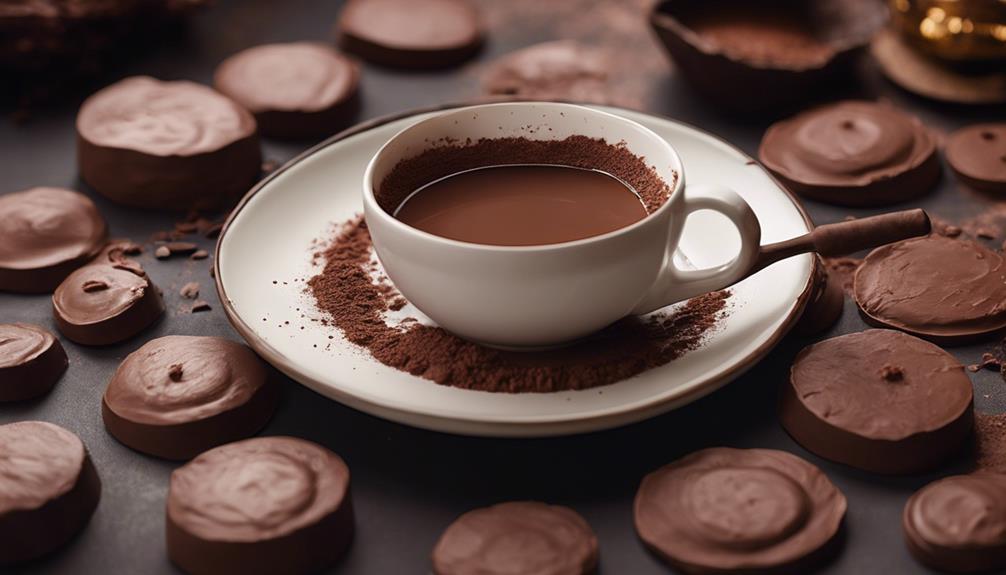
I blend 15-40 cacao discs with 5-6oz of heated liquid to create a creamy ceremonial cacao drink. The cacao discs, rich in plant medicine, are essential for this sacred ritual. The liquid can be water, milk, or even herbal tea, chosen based on your preference.
Heating the liquid helps the cacao discs melt smoothly, infusing the drink with their deep flavors. As I blend them together, I watch as the mixture transforms into a velvety concoction, ready to be savored.
This process of blending isn't just about mixing ingredients; it's about merging energies, creating a harmonious blend of cacao and liquid. The act of blending is a meditative practice, allowing me to connect with the essence of the cacao and prepare it for consumption.
This step sets the foundation for the ceremonial experience, ensuring that every sip is filled with intention and reverence for this ancient plant medicine.
Add Sweetener if Desired
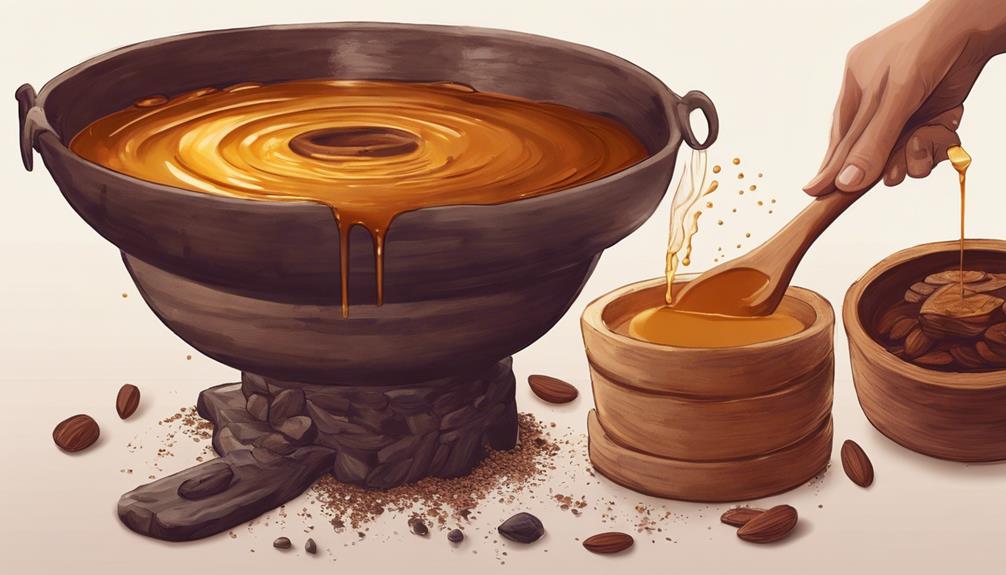
After blending the cacao discs with your chosen liquid, the next step is to enhance the flavor profile by adding a natural sweetener if desired. When it comes to making ceremonial cacao, adding a touch of sweetness can truly elevate the experience. Here are some natural sweeteners you might consider incorporating into your cacao blend:
- Raw Honey: This natural sweetener not only adds a lovely sweetness but also brings its unique flavor profile, enhancing the depth of the cacao.
- Coconut Blossom Sugar: A less refined alternative to traditional sugar, coconut blossom sugar can add a subtle caramel-like sweetness to your ceremonial cacao.
- Sweet Freedom: This natural sweetener made from fruit extracts can provide a delicate sweetness without overpowering the rich taste of the cacao.
Experimenting with these sweeteners can help you find the perfect balance to create a cacao drink that suits your palate. Remember, the sweetness level is entirely up to you, so feel free to adjust it based on your taste preferences.
Set Meaningful Intention Before Sipping
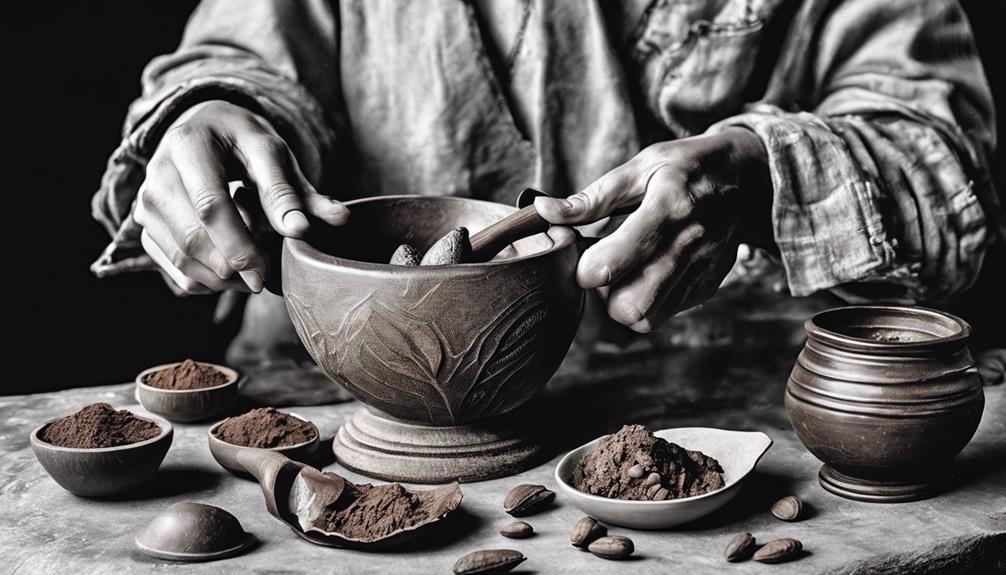
Prior to indulging in your ceremonial cacao, it's crucial to establish a meaningful intention. This process aids in directing your thoughts and emotions throughout the ritual, harmonizing your energy with your objectives.
Intent Clarity Importance
Setting a meaningful intention before sipping ceremonial cacao is essential for amplifying the energy and purpose of the ritual experience. When it comes to intent clarity, here's why it's pivotal:
- Focus Energy: Clarity in intent helps direct the energy flow during the ceremony.
- Purpose Alignment: Setting an intention creates a clear direction for the mind, body, and spirit alignment.
- Transformative Experience: By establishing a purpose, you prepare yourself for a potentially powerful and transformative journey.
Heartfelt Connection Ritual
To enhance the depth of the ceremonial cacao experience, infusing a heartfelt connection ritual by setting a meaningful intention before sipping is a practice that magnifies the ritual's essence.
Before indulging in the rich cacao elixir, take a moment to reflect on your innermost desires. Close your eyes, breathe deeply, and let your intentions flow from the heart onto paper. Writing down your intentions helps focus the mind, bringing clarity to the ceremony. This sacred act creates a space for genuine connection and invites positive energy to envelop you.
Choose intentions that resonate with your personal growth, healing journey, or feelings of gratitude. By setting intentions before sipping ceremonial cacao, you infuse the experience with depth and mindfulness, allowing for a profound connection with yourself and the sacred brew.
Mindful Sip Reflection
Enhancing the ceremonial cacao experience begins with infusing a heartfelt intention before sipping, allowing for a deeper connection to the ritual's essence. Setting a meaningful intention can help focus the mind and bring clarity to the ceremony. Reflecting on this intention while sipping the cacao can deepen the connection to the heart and the ceremony.
Here are some ways intention setting can enhance your ceremonial cacao experience:
- Clarifies your purpose for the ceremony
- Guides your energy towards specific goals
- Amplifies the effects of the cacao on your mind and spirit
Mindful sipping encourages presence and awareness during the cacao ceremony, enriching the spiritual journey you engage in with each sip.
Experience the Rich Flavors Mindfully
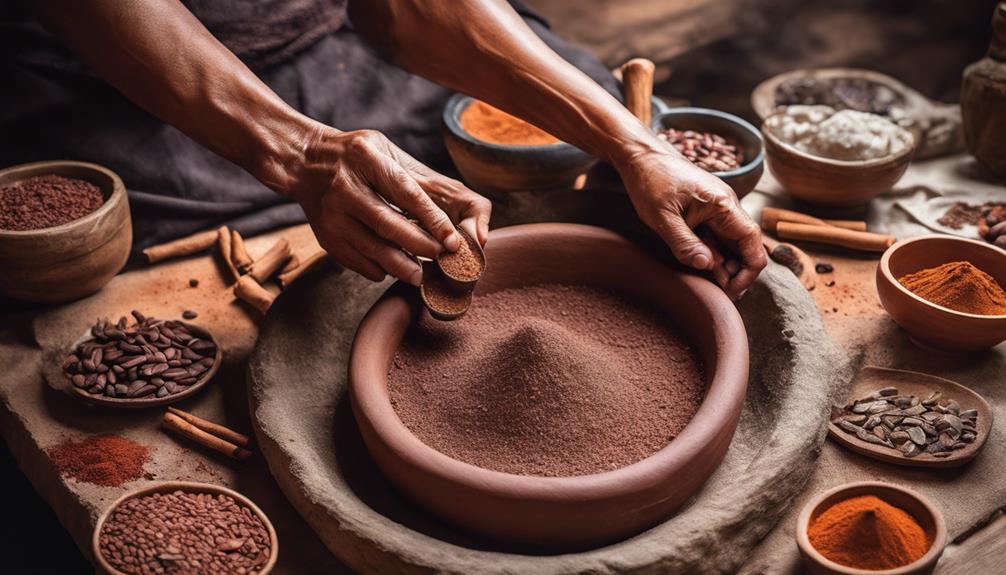
Savoring the rich flavors of ceremonial cacao mindfully can deepen the experience and evoke a sense of connection and warmth. When I take my first sip, I let the velvety texture envelop my senses, allowing the earthy undertones to dance on my palate. To fully appreciate the flavors, I suggest focusing on each sip, noticing the subtle shifts in taste as the cacao unfolds its complexity. Here's a simple guide to help you experience the rich flavors of ceremonial cacao mindfully:
| Step | Description |
|---|---|
| 1. Smell | Inhale deeply to capture the cacao's aroma. |
| 2. Taste | Allow the cacao to linger on your tongue. |
| 3. Feel | Notice the warmth spreading through your body. |
Engaging with ceremonial cacao in this way can elevate your day-to-day experience, turning a simple act of drinking into a ritual of connection and presence.
Embrace the Benefits of Ceremonial Cacao
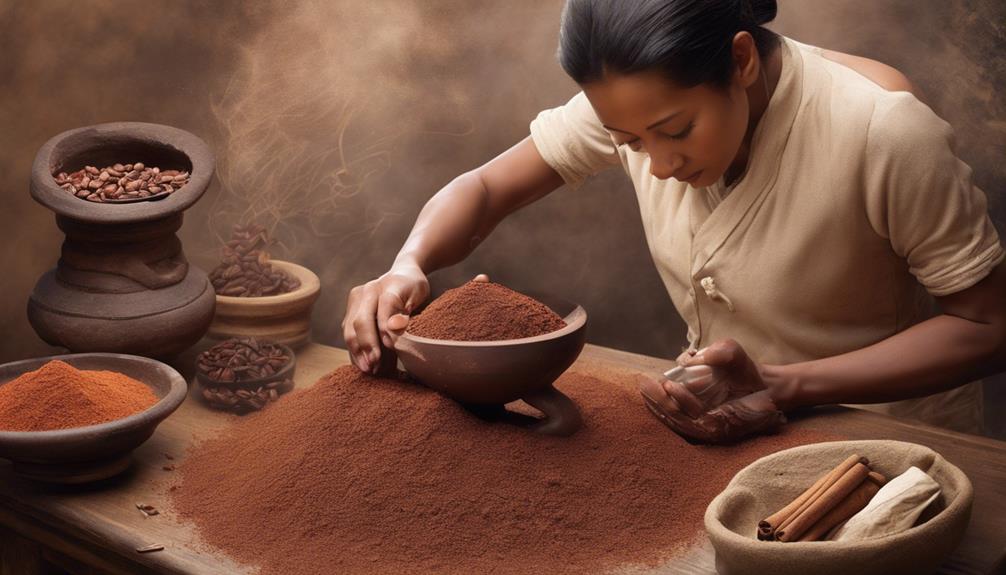
Embracing the benefits of ceremonial cacao brings about a sense of heart-opening and profound effects. When you open yourself to the magic of ceremonial cacao, you'll experience:
- Enhanced meditation practices: Ceremonial cacao has been known to deepen meditation experiences, allowing for a more profound connection to your inner self.
- Increased creativity: The heart-opening properties of ceremonial cacao can stimulate creativity, helping you tap into new ideas and inspiration.
- Improved energy and focus: Consuming ceremonial cacao can lead to a boost in energy levels and a heightened sense of focus, especially centered around the heart space.
Reflect on Your Cacao Ceremony
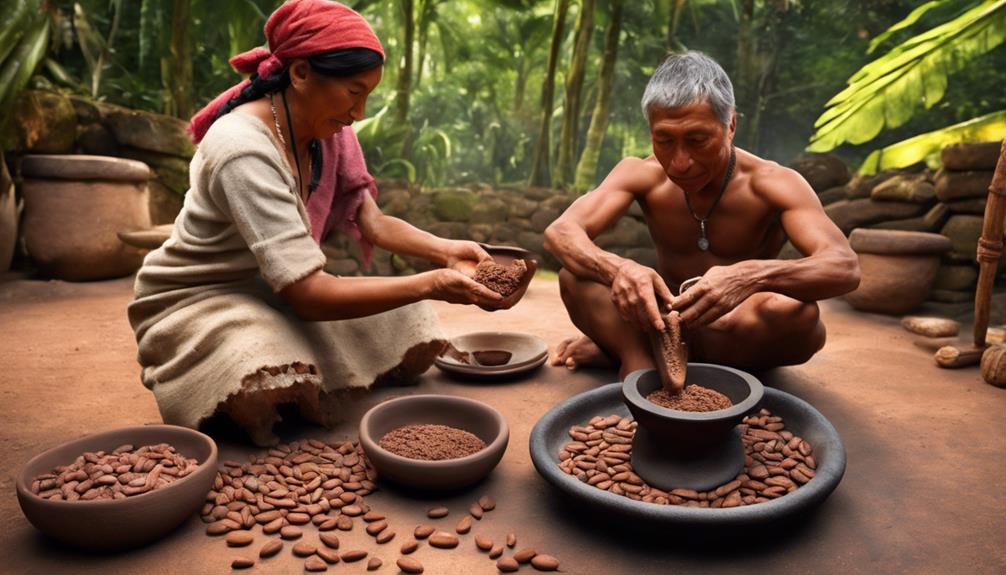
As I reflect on the recent cacao ceremony, it's vital to explore the profound effects it had on my overall well-being and state of mind. Taking time to ponder the experience can help integrate the insights gained and understand the impact of the ceremonial cacao on different aspects of my being.
| Aspects to Reflect On | Notes |
|---|---|
| Physical | Felt energized and nourished |
| Mental | Experienced clarity and focus |
| Emotional | Emotions of gratitude and peace |
| Messages/Guidance | Received insights on self-care |
Recording in a journal about these aspects can help capture the emotions, thoughts, and intentions during the ceremony. It's fundamental to give thanks for the experience and any messages or guidance received. Evaluating how the ceremonial cacao made me feel physically, mentally, and emotionally allows for a deeper understanding of the impact it had on my overall well-being.
Share Your Ceremonial Cacao Journey
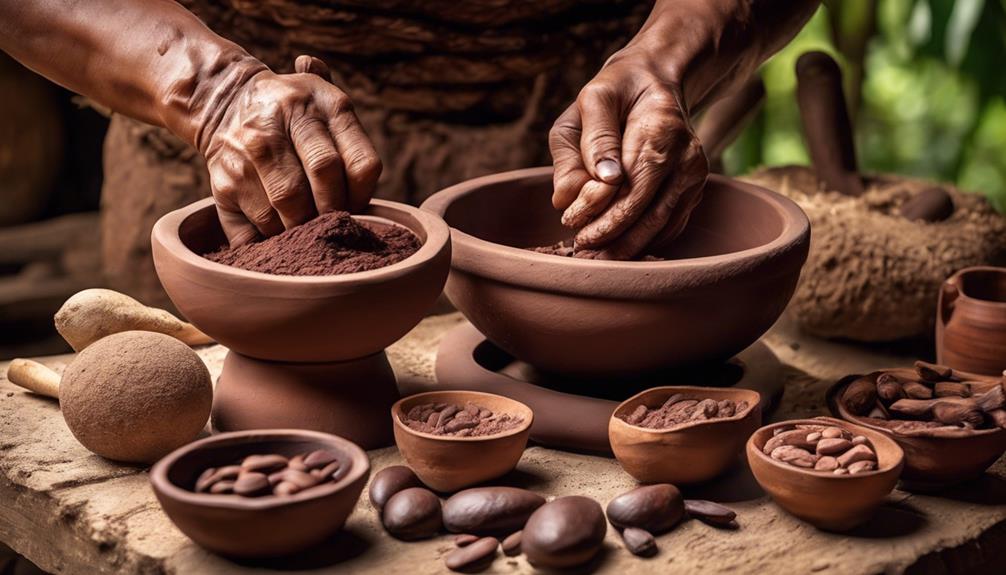
Reflecting on the transformative power of preparing and consuming ceremonial cacao has been an enlightening journey. Sharing my ceremonial cacao journey has allowed me to connect more deeply with the ritual and its benefits. Here are some insights I've gained along the way:
- Emotional Release: The ceremonial cacao has helped me release built-up emotions and tensions, allowing me to feel more relaxed and at peace.
- Connection to Self: Through this practice, I've developed a deeper connection to my inner self, fostering self-awareness and mindfulness.
- Nervous System Support: I've noticed that the ceremonial cacao has a calming effect on my nervous system, helping me feel more grounded and centered in my daily life.
Sharing your own ceremonial cacao journey can't only deepen your experience but also inspire others to explore the profound effects this ritual can have on both mind and body.
Frequently Asked Questions
How to Do a Cacao Ceremony Step by Step?
To do a cacao ceremony step by step, I connect with the cacao essence, set intentions, and honor the sacredness of the ritual. I mindfully prepare the cacao, infusing love and gratitude into each step for a soulful experience.
How Is Ceremonial Cacao Made?
Brewing ceremonial cacao is like crafting a warm hug in a cup. I gently warm milk, add ceremonial cacao, whisk until melted, and pour it into a special cup. Sweeteners and spices can elevate this sacred experience.
How Many Tablespoons of Cacao for Ceremonial?
For a ceremonial experience, I typically use 42g (around 3 tablespoons) of cacao per person. Adjust based on personal preference and intention. Start with a moderate amount and increase as desired for a heart-warming experience.
How Much Water Do You Need for Ceremonial Cacao?
I usually go for 100-200ml of water or milk for my ceremonial cacao. The amount of water impacts the richness; less water means a stronger flavor, more for a milder taste. Experiment to find your ideal balance.
Is a Shortcut Method for Making Cacao Just as Effective for Ceremonial Purposes?
Yes, you can make cacao in 3 steps and still have an effective ceremonial experience. The key is to use high-quality cacao and to focus on your intention and mindset while making and drinking the cacao. The simplicity of the method does not diminish its effectiveness for ceremonial purposes.
Conclusion
Now that you've learned how to make ceremonial cacao in 10 steps, it's time to experience the magic for yourself. The rich flavors, benefits, and mindful ceremony await you.
So gather your ingredients, heat your water, and blend with intention. Embrace the journey of ceremonial cacao and let it transport you to a place of reflection and connection.
Share your experience with others and continue to explore the world of this ancient ritual.
Rachael, the Editor in Chief of RachaelsRawFood.com, is an inspiring and passionate individual who has dedicated her life to promoting the benefits of a raw food lifestyle. Known for her vibrant and energetic personality, Rachael has built a strong online presence that has transformed her personal journey into a thriving community of raw food enthusiasts.
Raw Food Ingredients
How Much Caffeine in Cocoa?
Not all cocoa products are created equal when it comes to caffeine content – discover which one might surprise you!

When evaluating the caffeine levels in cocoa, it’s important to recognize that dark chocolate contains around 43 mg of caffeine per 100 grams due to its high cocoa solid content. Dark chocolate has a higher caffeine content compared to milk or white chocolate. This means that consuming dark chocolate in moderation can assist in managing your caffeine intake. On the other hand, milk chocolate has around 20 mg of caffeine per 100 grams while white chocolate is caffeine-free. Cocoa powder, commonly used in baking and beverages, contains a substantial 230 mg of caffeine per 100 grams. Being aware of these distinctions in chocolates can help you make informed decisions about your caffeine consumption.
Key Takeaways
- Caffeine content in cocoa varies based on cocoa solid concentrations.
- Unsweetened cocoa powder can contain around 230 mg of caffeine per 100 grams.
- Roasting cocoa solids influences the final caffeine content in cocoa products.
- Dark chocolate, with high cocoa solid content, has more caffeine than milk chocolate.
- Moderate consumption of cocoa products helps manage caffeine intake.
Caffeine Content in Dark Chocolate
Dark chocolate boasts a caffeine content of approximately 43 mg per 100 grams, mainly deriving from its higher cocoa solid composition. When we indulge in this decadent treat, we aren't only savoring its rich cocoa flavor but also a subtle caffeine kick. Compared to milk or white chocolate, dark chocolate contains a higher amount of caffeine.
Please bear in mind that moderate consumption of dark chocolate can assist individuals in managing their caffeine intake effectively. The caffeine levels in dark chocolate are about one-fourth of what you'd find in a standard cup of coffee. So, if you're looking for a milder caffeine boost, a piece of dark chocolate might just do the trick without the jitters that sometimes accompany a strong cup of coffee.
Enjoy your dark chocolate in moderation, savoring both its taste and the gentle pick-me-up it provides.
Caffeine Levels in Milk Chocolate

Milk chocolate, known for its creamy texture and sweet flavor, contains a modest caffeine content of approximately 5.6 mg per ounce, as indicated by USDA data. Unlike dark chocolate, milk chocolate has a lighter color due to lower cocoa content, resulting in reduced caffeine levels.
The delightful creamy taste in milk chocolate comes from a harmonious blend of cocoa and milk powder. While dark chocolate boasts higher caffeine content, milk chocolate remains a popular choice for those seeking a sweet treat with minimal caffeine intake.
Caffeine Presence in White Chocolate
With its unique composition excluding cocoa solids, white chocolate stands out as a caffeine-free alternative to its darker counterparts. White chocolate is crafted from a blend of cocoa butter, milk powder, sugar, and vanilla, making it a delectable treat without the stimulating effects of caffeine. For individuals sensitive to caffeine, white chocolate offers a creamy texture and indulgent flavor without the worry of unwanted side effects. This makes it a popular choice for desserts among those looking to steer clear of caffeine in their sweet treats.
Compared to dark chocolate, which contains cocoa solids and hence caffeine, white chocolate provides a caffeine-free option for those seeking a more mellow indulgence. So, if you're in the mood for a luscious and smooth chocolate experience without the buzz of caffeine, white chocolate is the perfect choice for your next dessert delight.
Impact of Cocoa Solids on Caffeine

In determining the caffeine levels in cocoa products, the percentage of cocoa solids plays a significant role. Here are some key points about the impact of cocoa solids on caffeine content:
- Caffeine Derivation: The caffeine content in cocoa primarily comes from cocoa solids, making it an important factor in determining the overall caffeine levels in cocoa-based products.
- Dark Chocolate: Dark chocolate, known for its higher cocoa solid content, tends to contain more caffeine compared to milk or white chocolate varieties due to this higher concentration.
- Unsweetened Cocoa Powder: A 100g serving of unsweetened cocoa powder can contain around 230mg of caffeine, reflecting the impact of the high cocoa solid content in this form.
- Health Benefits: The roasting process of cocoa solids not only affects the flavor profile but also influences the caffeine content, contributing to the potential health benefits associated with consuming cocoa products like hot cocoa.
Comparing Caffeine in Different Chocolates
Comparing the caffeine content in different chocolates reveals varying levels based on their cocoa solid concentrations. Dark chocolate contains about 43 mg of caffeine per 100 grams, making it a stronger caffeinated option compared to milk chocolate, which only has around 20 mg per 100 grams.
Surprisingly, white chocolate, derived from cocoa butter, doesn't contain any caffeine at all. For those seeking a more potent caffeine kick, cocoa powder is the way to go, boasting a high concentration of 230 mg per 100 grams.
The amount of caffeine in chocolate products is closely linked to the cocoa solid content, with dark chocolate containing the highest levels. So, the next time you're craving a chocolate treat but also need a little energy boost, opt for dark chocolate to get the most caffeine per bite.
Frequently Asked Questions
Is There More Caffeine in Cocoa Than Coffee?
There's more caffeine in cocoa than in coffee. Cocoa powder packs 230 mg per 100 grams, surpassing most coffee varieties. Dark chocolate has even more caffeine due to higher cocoa content. It's a rich, unique energy source.
Is There a Lot of Caffeine in Hot Cocoa?
There isn't a lot of caffeine in hot cocoa. It depends on the brand and recipe. Starbucks hot chocolate has around 25 mg per serving, while basic mixes have about 5 mg. The amount of cocoa powder used influences the caffeine content.
Is There Caffeine in Hershey's Cocoa?
Absolutely, Hershey's Cocoa does contain caffeine, but it's not overwhelming. It adds a delightful hint of energy in each spoonful. Perfect for baking or a cozy cup of hot chocolate. Just the right amount!
Is Cocoa a Stimulant Like Caffeine?
Cocoa stimulates like caffeine due to its theobromine content. Decaf versions offer a solution for caffeine-sensitive folks. Options include regular cocoa with caffeine, Dutch-processed cocoa with less, and decaf cocoa with reduced caffeine while keeping healthful compounds.
What are the potential health effects of consuming high levels of caffeine in cocoa?
Unveiling cocoa caffeine levels can lead to potential health effects of excessive consumption. High levels of caffeine in cocoa may contribute to insomnia, nervousness, and fast heartbeat. It can also cause gastrointestinal discomfort and exacerbate anxiety disorders. Moderation in consuming caffeinated cocoa products is recommended for overall health.
Conclusion
To sum up, the caffeine content in cocoa varies depending on the type of chocolate. Dark chocolate typically has the highest caffeine levels, followed by milk chocolate and white chocolate. The amount of cocoa solids in the chocolate also affects the caffeine content.
Remember, just like different chocolates have different levels of caffeine, we all have unique strengths and abilities. Embrace your individuality and always aim for balance in everything you do.
Rachael, the Editor in Chief of RachaelsRawFood.com, is an inspiring and passionate individual who has dedicated her life to promoting the benefits of a raw food lifestyle. Known for her vibrant and energetic personality, Rachael has built a strong online presence that has transformed her personal journey into a thriving community of raw food enthusiasts.
Raw Food Ingredients
5 Key Differences: Caffeine Content in Cocoa Vs Coffee
Open the door to understanding the contrasting caffeine levels in cocoa and coffee, revealing surprising insights that will reshape your beverage choices.

When comparing the caffeine levels in cocoa and coffee, it is important to understand that cocoa generally has lower caffeine content than coffee. Dark chocolate contains approximately 12 milligrams of caffeine per ounce, while hot cocoa typically ranges from 5 to 10 milligrams per ounce. In contrast, brewed coffee can have significantly higher levels, varying from 95 to 165 milligrams per 8-ounce cup.
Cocoa is considered a milder option for individuals aiming to limit their caffeine intake, with theobromine providing a gradual energy increase. Meanwhile, coffee's caffeine content offers immediate alertness, and understanding these distinctions can help you select based on your preferred effects.
Key Takeaways
- Cocoa contains lower caffeine levels but compensates with theobromine for a gradual energy increase.
- Coffee has higher caffeine content, offering an immediate alertness boost and potentially higher metabolic rate.
- Theobromine in cocoa promotes relaxation, while caffeine in coffee provides intense alertness and mood fluctuations.
- Hot chocolate is a good option for reducing caffeine intake while still benefiting from theobromine effects.
- Understanding caffeine variances helps make informed choices for desired energy levels and mood effects.
Caffeine Levels in Cocoa Vs Coffee
When comparing caffeine levels in cocoa versus coffee, it's evident that cocoa generally contains lower amounts per serving. Dark chocolate, made from cacao beans, contains around 12 milligrams of caffeine per ounce, while a 1-ounce serving of hot cocoa mix typically has 5-10 milligrams. Even a 16-ounce serving of Starbucks hot chocolate only contains about 25 milligrams of caffeine.
On the other hand, coffee, when brewed, can range from 95 to 165 milligrams of caffeine per 8-ounce cup, depending on the type and brewing method. This significant difference in caffeine content between cocoa and coffee makes cocoa a milder option for those looking to limit their caffeine intake.
Impact on Alertness and Energy

Typically, the immediate alertness and energy boost from caffeine in coffee can last for hours. This surge in alertness is due to caffeine's stimulating effect on the central nervous system. On the other hand, cocoa contains theobromine, which provides a more gradual increase in energy levels. Unlike caffeine, theobromine doesn't cause sudden spikes and crashes, offering a smoother energy curve.
Coffee's caffeine content can temporarily boost the metabolic rate, potentially supporting weight management efforts. This increased metabolic rate can aid in burning calories and may contribute to weight loss when combined with a balanced diet and regular exercise. Additionally, theobromine in cocoa contributes to the thermogenic effect, leading to mild calorie burning in the body.
Both caffeine and theobromine can influence mood. Caffeine tends to provide a more intense and quick-acting mood elevation, while theobromine promotes feelings of relaxation and contentment. Understanding the differences in alertness, energy, metabolic effects, and mood enhancements between cocoa and coffee can help individuals make informed choices based on their preferences and wellness goals.
Metabolic Variances and Effects
Regarding metabolic variances and effects, the varying caffeine levels between cocoa and coffee play a significant role. When comparing the metabolic impact of caffeine in cocoa and coffee, it is crucial to note that cocoa contains lower levels of caffeine but compensates with theobromine, which aids in the thermogenic effect, promoting calorie burning and metabolic activity. On the other hand, coffee, especially brewed varieties, contains higher levels of caffeine, potentially providing a temporary boost to the metabolic rate, which could assist in weight management. While caffeine in coffee offers a quick energy surge, theobromine in cocoa leads to a more gradual rise in energy levels, avoiding sudden spikes and crashes. To summarize the metabolic differences, I've created a table below:
| Aspect | Cocoa | Coffee |
|---|---|---|
| Caffeine Content | Lower levels | Higher levels |
| Additional Component | Theobromine | Caffeine |
| Metabolic Impact | Thermogenic effect | Temporary metabolic rate boost |
| Energy Levels | Gradual rise | Quick surge |
| Weight Management | Aids in calorie burning | Potential assistance |
Mood Enhancement Disparities

In comparing the mood enhancement effects of theobromine in cocoa and caffeine in coffee, notable disparities emerge in their impact on mental well-being.
The theobromine found in cocoa promotes relaxation and contentment, offering a gradual rise in energy levels that leads to a gentle and long-lasting mood enhancement experience.
On the other hand, caffeine delivers an intense and fast-acting boost in alertness, providing immediate energy levels that can lead to abrupt spikes and crashes.
While both theobromine and caffeine uplift mood, theobromine's effects are characterized by a steady and gradual increase in energy levels, creating a sense of calm and contentment.
In contrast, caffeine's impact is more intense and temporary, resulting in rapid alertness but also the potential for fluctuations in mood. Understanding these differences can help individuals choose between cocoa and coffee based on their desired mood enhancement effects.
Health Implications and Considerations
Health implications and considerations surrounding caffeine consumption warrant close attention due to its potential impact on various aspects of well-being. When comparing a cup of coffee to hot chocolate, it's vital to note the amount of caffeine present.
While coffee contains much caffeine, hot chocolate has less caffeine but isn't entirely devoid of it. The main active ingredients in hot chocolate are theobromine and caffeine, where theobromine is a relative of caffeine and also has stimulant effects, although milder. If you're looking to reduce your caffeine intake, opting for hot chocolate over a cup of coffee can be a good choice.
Being mindful of the caffeine content in chocolate products is important, especially if you're sensitive to caffeine or belong to vulnerable populations like children or pregnant women. Understanding the caffeine levels in different beverages allows you to make informed decisions about your consumption for better overall health.
Frequently Asked Questions
Is There Caffeine in Coffee Vs Cacao Powder?
Yes, there is caffeine in coffee, with around 140 milligrams in a 12-ounce cup. On the other hand, cacao powder contains only about 12 milligrams per tablespoon, making it a great caffeine-free alternative for those seeking a milder boost.
What Is the Difference Between Cocoa and Coffee?
When comparing cocoa and coffee, cocoa offers a rich, chocolatey flavor and is packed with antioxidants and minerals. Coffee, on the other hand, provides a robust, bitter taste and a jolt of caffeine for that morning pick-me-up.
Why Is Cocoa Better Than Coffee?
I believe cocoa is superior to coffee because it offers a gentler energy boost, promotes relaxation and contentment, and provides sustained vitality without sudden crashes. Plus, dark chocolate's theobromine supports cellular health and tastes delicious.
How Much Caffeine Is in Cocoa Powder Vs Decaf Coffee?
In cocoa powder vs decaf coffee, cocoa has 12-26mg of caffeine per tbsp, while decaf coffee holds 2-5mg per 8-ounce cup. The choice hinges on desired caffeine levels and flavor. I prefer cocoa's lower caffeine content.
How does the caffeine content in hot chocolate compare to coffee?
Hot chocolate caffeine content is significantly lower than that of coffee. While an 8-ounce cup of hot chocolate contains about 5-10 milligrams of caffeine, the same size of coffee can have anywhere from 95-200 milligrams. It’s a notable difference for those looking to limit their caffeine intake.
Conclusion
To sum up, while cocoa and coffee both contain caffeine, the levels vary significantly. Cocoa generally has lower caffeine content compared to coffee, impacting alertness, energy levels, and mood enhancement differently.
It's crucial to keep these differences in mind when choosing between the two beverages for your daily consumption. Remember, moderation is key to maintaining a healthy balance in your caffeine intake.
So, whether you prefer a cup of cocoa or a mug of coffee, enjoy it in moderation for the best benefits!
Rachael, the Editor in Chief of RachaelsRawFood.com, is an inspiring and passionate individual who has dedicated her life to promoting the benefits of a raw food lifestyle. Known for her vibrant and energetic personality, Rachael has built a strong online presence that has transformed her personal journey into a thriving community of raw food enthusiasts.
Raw Food Ingredients
A Guide to Becoming a Good King
Kingship demands wisdom, fairness, integrity, courage, and humility – essential traits for a successful reign and prosperous kingdom." Keep reading to uncover the secrets of becoming a good king.

In order to be a good king, one must embody wisdom, fairness, integrity, courage, and humility to lead the kingdom with honor. Wisdom is essential for making important decisions, fairness ensures just treatment for all, integrity builds trust and respect, courage is crucial for facing challenges, and humility reminds us of our humanity. Historical kings such as Solomon, Arthur, David, Charlemagne, and Ramses II serve as role models for these leadership traits.
As a king, embracing challenges, understanding the world, seeking personal growth, and learning from the past are essential responsibilities. Developing leadership skills, making wise decisions, and prioritizing the well-being of the people are key to effective kingship. Every step on the path to becoming a good king is critical for a successful reign and prosperous kingdom.
Key Takeaways
- Embrace wisdom for informed decisions.
- Practice fairness for just treatment.
- Uphold integrity to earn trust.
- Show courage in facing challenges.
- Maintain humility for empathy and respect.
Qualities of a Good King
Being a good king requires embodying qualities such as wisdom, fairness, integrity, courage, humility, and compassion in decision-making and leadership. Power comes with responsibility, and as a king, it's essential to wield this power wisely. Wisdom is vital in making sound judgments that benefit the kingdom as a whole. Fairness guarantees that all subjects are treated justly and equitably, fostering a harmonious society. Integrity is the foundation of trust and respect, key elements in effective leadership.
Courage is necessary to face challenges and make difficult decisions, even when met with opposition. Humility reminds a king of his humanity and the importance of humility in interactions with all subjects. Compassion demonstrates a king's care and empathy towards his people, fostering a sense of unity and loyalty. Effective communication is crucial for conveying decisions, listening to concerns, and inspiring confidence in leadership.
Historical Kings as Role Models

King Solomon, renowned for his wisdom and leadership, stands as an exemplar among historical kings who serve as role models for future leaders. Looking at figures like King Arthur, known for his justice and valor in medieval legends, and King David, celebrated for his faith and courage in battle, we find lessons that transcend time. Charlemagne's legacy of military conquests and cultural revival, alongside Ramses II's grand building projects and military campaigns, offer diverse insights into effective kingship. Below is a table summarizing key attributes of these historical kings:
| King | Attributes |
|---|---|
| King Solomon | Wisdom, leadership |
| King Arthur | Justice, valor |
| King David | Faith, courage |
| Charlemagne | Military prowess, culture revival |
| Ramses II | Building projects, military campaigns |
Studying these historical figures can provide valuable lessons on the multifaceted qualities that make a great ruler.
Responsibilities of Kingship
Embracing challenges and living authentically are central to fulfilling the responsibilities inherent in kingship. As men aspiring to be good kings, it's essential for us to understand that the world requires leaders who are kind, humble, and committed to personal growth.
The journey to becoming a good king involves more than just wielding power and responsibility—it entails sacrificing comfort for growth and transformation. Seeking the ancient path of masculinity, as exemplified by figures like Morgan, teaches us the importance of humility, vulnerability, and character development.
In fulfilling the responsibilities of kingship, we're entrusted with power not for our own gain, but for the betterment of the world around us. Just as seeds need Good Soil to flourish, we must nurture our own growth to lead effectively.
Leadership Skills for Kings

Developing essential leadership skills is crucial for aspiring kings seeking to fulfill their responsibilities with humility, vulnerability, and a focus on character development. As you study the world around us, the power and responsibility of what kingship entails become clearer. Here are some key points to think about on your path to becoming a king:
- Embrace challenges and live authentically.
- Seek ancient paths of masculinity for guidance.
- Reflect on your identity, purpose, and ability to be entrusted with power for good.
- Sacrifice comfort for growth, transformation, and participation in universal creativity.
The journey of becoming a king isn't just about gaining authority but about understanding the remarkable fellowship of like-hearted individuals who share similar goals. Engage in group discussion questions, consider between-session personal study, and explore the depths of your masculine soul. This is the path to restoring what it means to be a true king.
Importance of Wise Decision-Making
Steering through the intricacies of leadership, especially in the domain of kingship, requires a sharp focus on the art of prudent decision-making. Wise decision-making is like the compass guiding the ship of leadership towards success.
Good kings understand that their choices impact not just themselves but also the lives of those they rule over. They prioritize the well-being of their people over personal gains, embodying the essence of true leadership.
Seeking counsel from trusted advisors and reflecting on core values are essential practices in the domain of wise decision-making. By embracing humility and self-awareness, kings can navigate the complex web of choices with clarity and integrity.
Just like a six-session video Bible study can guide individuals in restoring the heart, wise decision-making is essential for becoming the kind of leaders our world needs. Let's start on this journey of radical reconstruction, where every decision is a step towards being counted among the good kings of history.
Frequently Asked Questions
What Is the Becoming a King Guide?
The Becoming a King guide is a transformative resource created by Morgan Snyder to help men grow into responsible kings. It offers practical tools and profound insights to aid personal development and transformation.
What Are the Qualities of a Good King?
Being a good king means embodying humility, wisdom, and integrity. Prioritizing the well-being of my people, making decisions for the greater good, and showing courage, justice, and compassion in all actions. Seeking counsel and valuing diverse perspectives is essential.
What Makes a True King?
Beneath the crown lies a heart that beats with humility and a spirit that soars with honor. True kings are forged in the fires of challenge, embracing authenticity and growth to inspire others.
What Makes a Real King?
Being a true king means embodying humility, courage, and empathy. It's about serving others and leading with integrity. I endeavor to cultivate these qualities daily, embracing challenges and seeking growth in all aspects of my life.
How Can Sacred Cacao be Incorporated Into Kingship Rituals?
In kingship rituals, the sacred cacao ritual holds great significance. The ceremonial drinking of cacao symbolizes the divine connection between the ruler and the spiritual realm. It is believed to impart wisdom and strength, making it a crucial element in the coronation and leadership rites of many cultures.
Conclusion
To sum up, becoming a good king requires a combination of qualities, skills, and responsibilities. Remember, 'With great power comes great responsibility.'
By studying historical kings as role models, practicing leadership skills, and making wise decisions, one can aspire to be a just and effective ruler.
It's a challenging path, but with dedication and perseverance, anyone can endeavor to be a worthy leader for their kingdom.
Rachael, the Editor in Chief of RachaelsRawFood.com, is an inspiring and passionate individual who has dedicated her life to promoting the benefits of a raw food lifestyle. Known for her vibrant and energetic personality, Rachael has built a strong online presence that has transformed her personal journey into a thriving community of raw food enthusiasts.
-

 Health and Wellness2 months ago
Health and Wellness2 months agoDoes Eating Raw Food Help You Lose Weight? Discover the Truth
-

 Raw Food Recipes2 months ago
Raw Food Recipes2 months agoHow Much Raw Food to Feed Your Puppy: Essential Tips
-

 Kitchen Essentials for Raw Food Preparation1 month ago
Kitchen Essentials for Raw Food Preparation1 month agoCan You Cook Raw Food in an Air Fryer? Discover the Possibilities
-

 Raw Food Recipes2 months ago
Raw Food Recipes2 months agoHow to Defrost Dog Raw Food Properly
-

 Health and Wellness2 months ago
Health and Wellness2 months agoHow Long Does It Take Bacteria to Spread From Raw Food? Essential Info
-
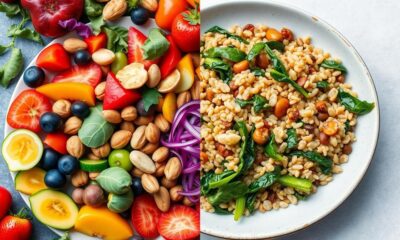
 Raw Food Recipes2 months ago
Raw Food Recipes2 months agoRaw Food Vs. Vegan: Which Diet Is Better?
-

 Raw Food Recipes2 months ago
Raw Food Recipes2 months agoIs Raw Food Good for Cats? Find Out Here
-

 Raw Food Recipes2 months ago
Raw Food Recipes2 months agoWhat Is the Raw Food Diet? A Comprehensive Overview




















